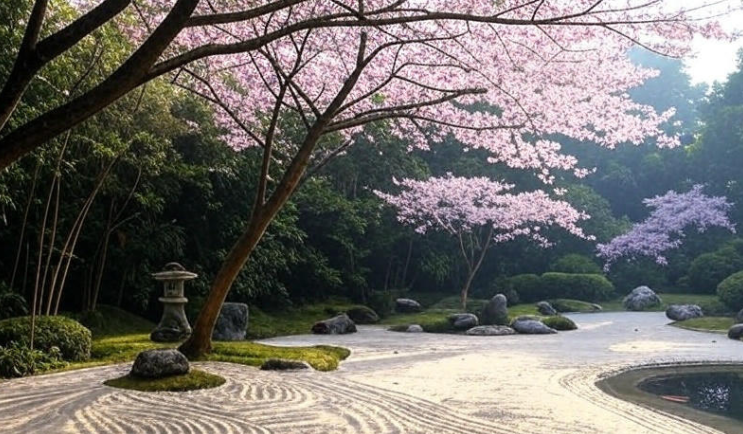There’s a unique stillness in Japan that can only be found when you’re standing before a perfectly raked bed of gravel, listening to the whisper of bamboo leaves, or watching moss quietly thrive over timeworn stones. Zen gardens—simple, silent, and steeped in centuries of thought—offer more than just visual beauty. They are spaces designed to still the mind and welcome presence. For travelers seeking a deeper connection to Japan’s spirit, these gardens are sanctuaries of meditation, reflection, and peace.
Table of Contents
ToggleThe Essence of Zen Gardens in Japanese Culture

History and Origins of Zen Gardens
Zen gardens, or karesansui (枯山水), originated from the Muromachi period (14th–16th century) under the influence of Zen Buddhism. Created not for strolling but for seeing, these dry landscape gardens were meant to aid in zazen (sitting meditation), offering monks a way to contemplate nature through minimalism. Sand and gravel represent water; rocks evoke islands, mountains, or even animals. Each detail is symbolic, intentional, and quietly profound.
Karesansui Garden: The Dry Landscape
A defining feature of Zen gardens is their dry composition. No ponds or waterfalls—just raked gravel, scattered rocks, and the occasional moss or shrub. The simplicity clears away distraction, leaving space for the mind to settle.
Principles of Japanese Rock Gardens
Zen gardens are guided by asymmetry, balance, and suggestion rather than representation. They’re designed to evoke the essence of nature, not mirror it directly. Common themes include impermanence, the void, and harmony. As you observe, your inner world begins to reflect that same order and calm.
Iconic Zen Gardens

Ryoan-ji (Kyoto)
Arguably Japan’s most famous Zen garden, Ryoan-ji is a minimalist masterpiece. Fifteen stones rest on white gravel in an arrangement so mysterious that from any vantage point, one stone is always hidden. It’s a puzzle for the soul—a quiet invitation to ponder imperfection and perspective.
Best season to visit: Spring for cherry blossoms in the surrounding park, or autumn for vibrant maple leaves.
Tenryu-ji (Arashiyama, Kyoto)
While more of a strolling garden, Tenryu-ji blends Zen with natural grandeur. Set against the Arashiyama mountains, its reflective pond and seasonal beauty offer a peaceful, open-air meditation space. The nearby bamboo forest completes the dream.
Best season to visit: Autumn (late November) for fiery fall foliage; spring also brings blooming cherry blossoms..
Zuiho-in (Kyoto, part of Daitoku-ji)
Less known but deeply soulful, Zuiho-in feels like a secret. Designed by a Christian daimyo, its checkerboard moss and rock layout is both bold and meditative. It’s often quiet—perfect for solo contemplation.
Best season to visit: Spring and early summer when the moss is lush and green.
Adachi Museum of Art (Shimane Prefecture)
This museum’s garden isn’t for walking—only for viewing, like a painting. Each season transforms the scene, framed perfectly by floor-to-ceiling windows. It’s a modern reinterpretation of Zen, equally meditative and visually exquisite.
Best season to visit: Autumn for fiery foliage or winter for snow-draped minimalism.
Ginkaku-ji (Kyoto)
The “Silver Pavilion” garden is poetic and still. A sea of white sand—meticulously raked—surrounds a mysterious cone-shaped mound known as the Moon Viewing Platform. Visit in the early morning when mist still clings to the trees.
Best season to visit: Early spring for cherry blossoms or late November for autumn colors.
Immersing Yourself in Zen: Meditation and Tea Ceremony
Meditative Practices in Zen Gardens
Many Zen temples offer zazen meditation sessions for visitors. You’ll sit silently, focusing on breath, posture, and awareness. Whether for ten minutes or an hour, these gardens provide the perfect backdrop for inner clarity. Even without formal meditation, just sitting quietly among gravel and stone can be transformative.
Tea Ceremony: A Spiritual Journey
Zen and tea go hand in hand. The Japanese tea ceremony (chanoyu) is a ritual of simplicity, grace, and presence. Held in garden teahouses or temple spaces, the experience invites you to slow down and savor the moment—every gesture, every sip, an act of mindfulness.
